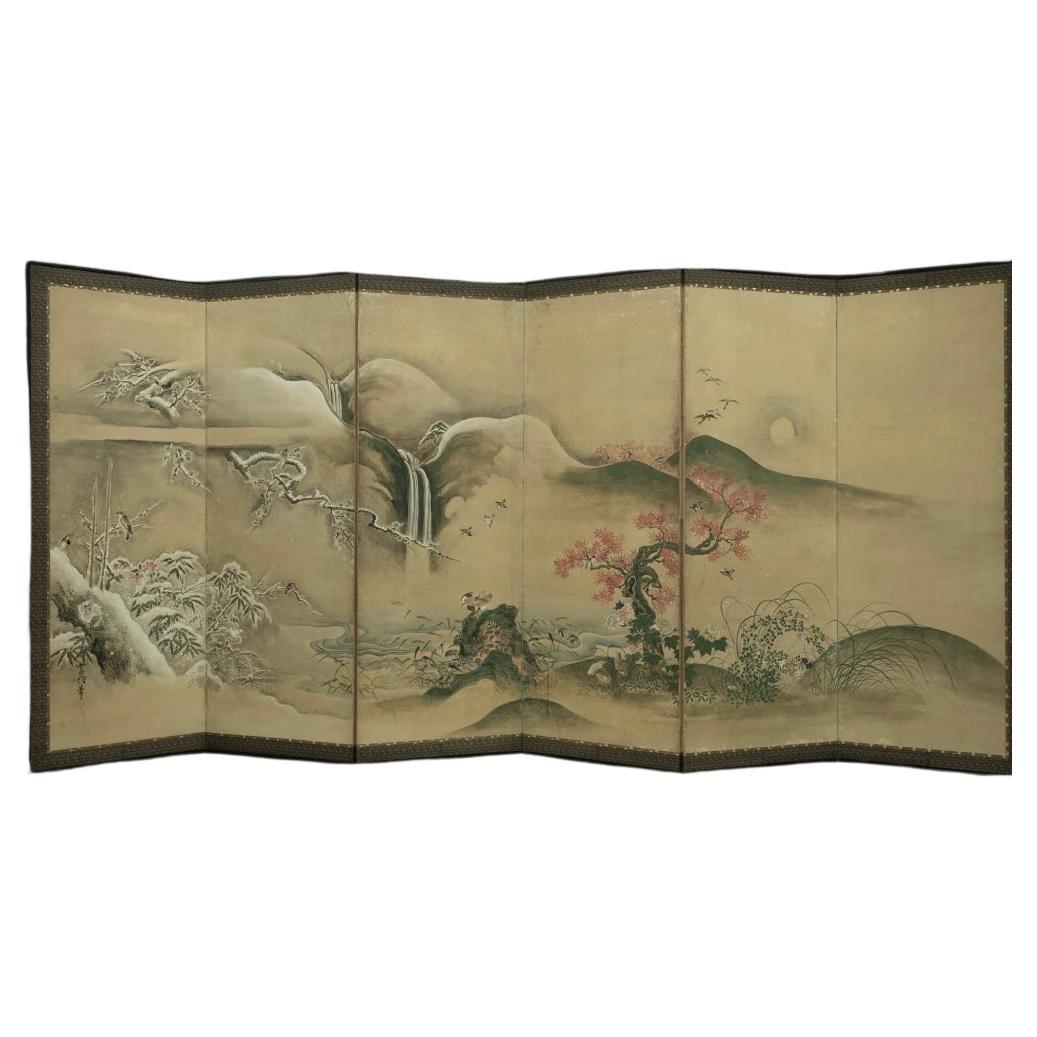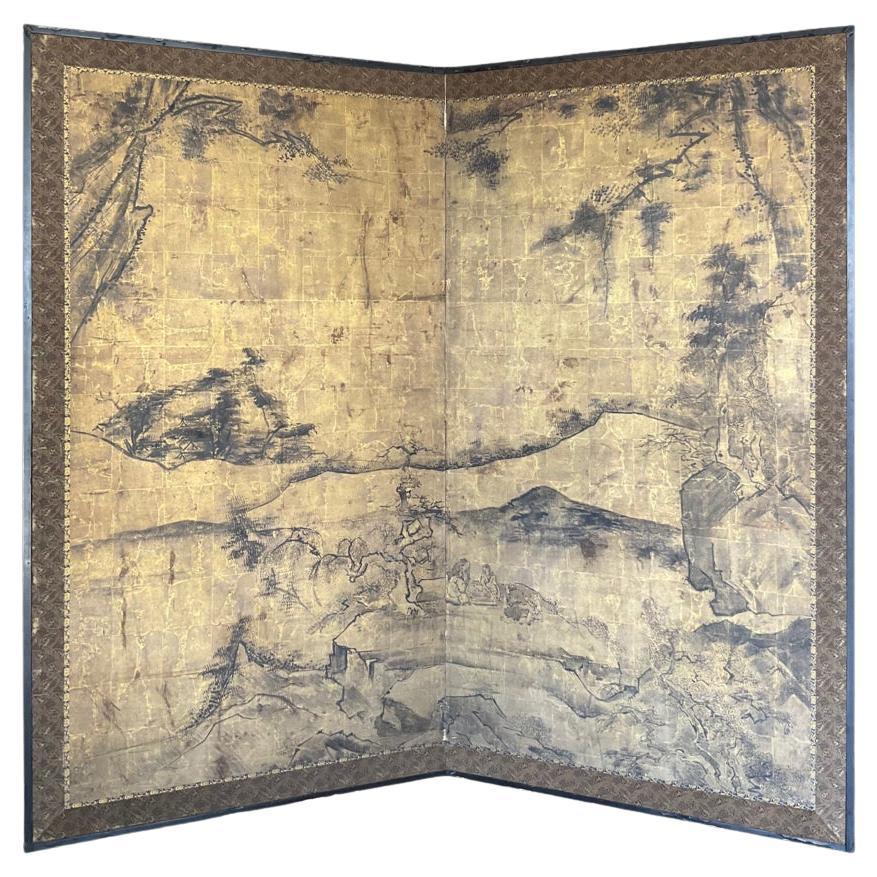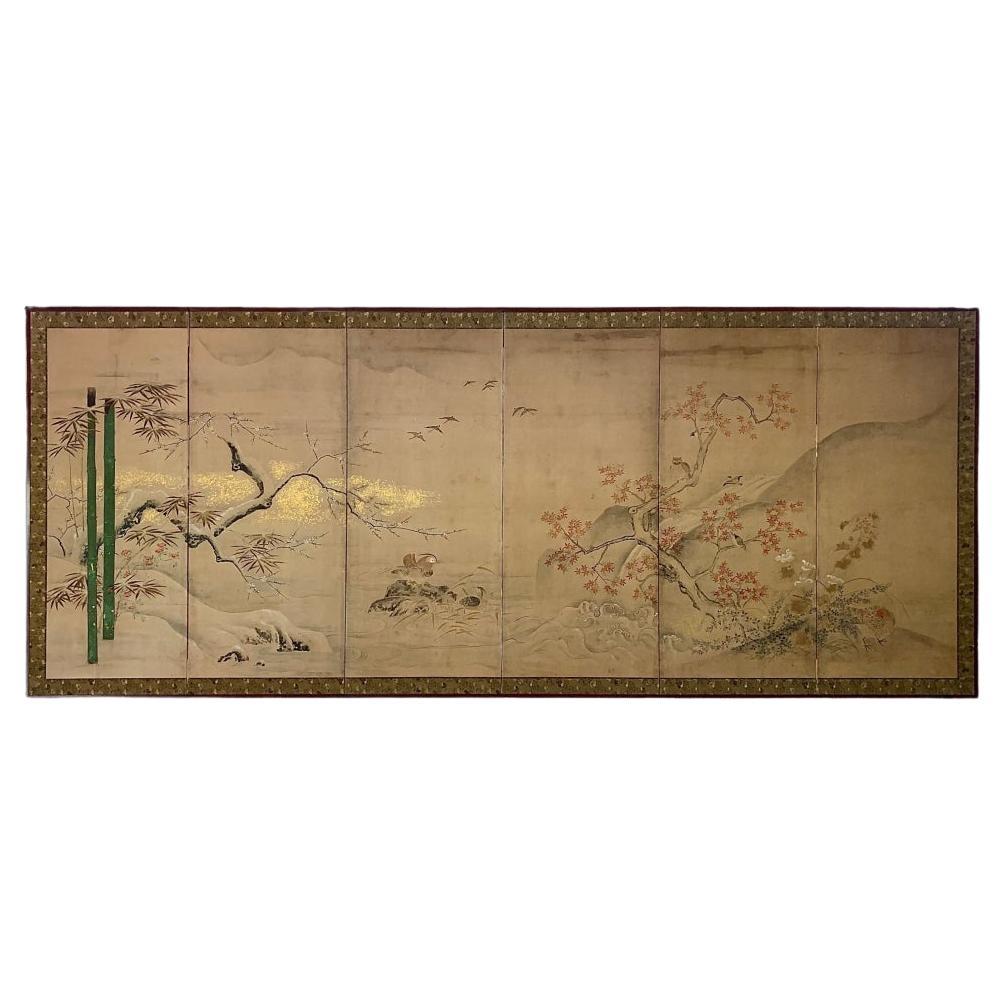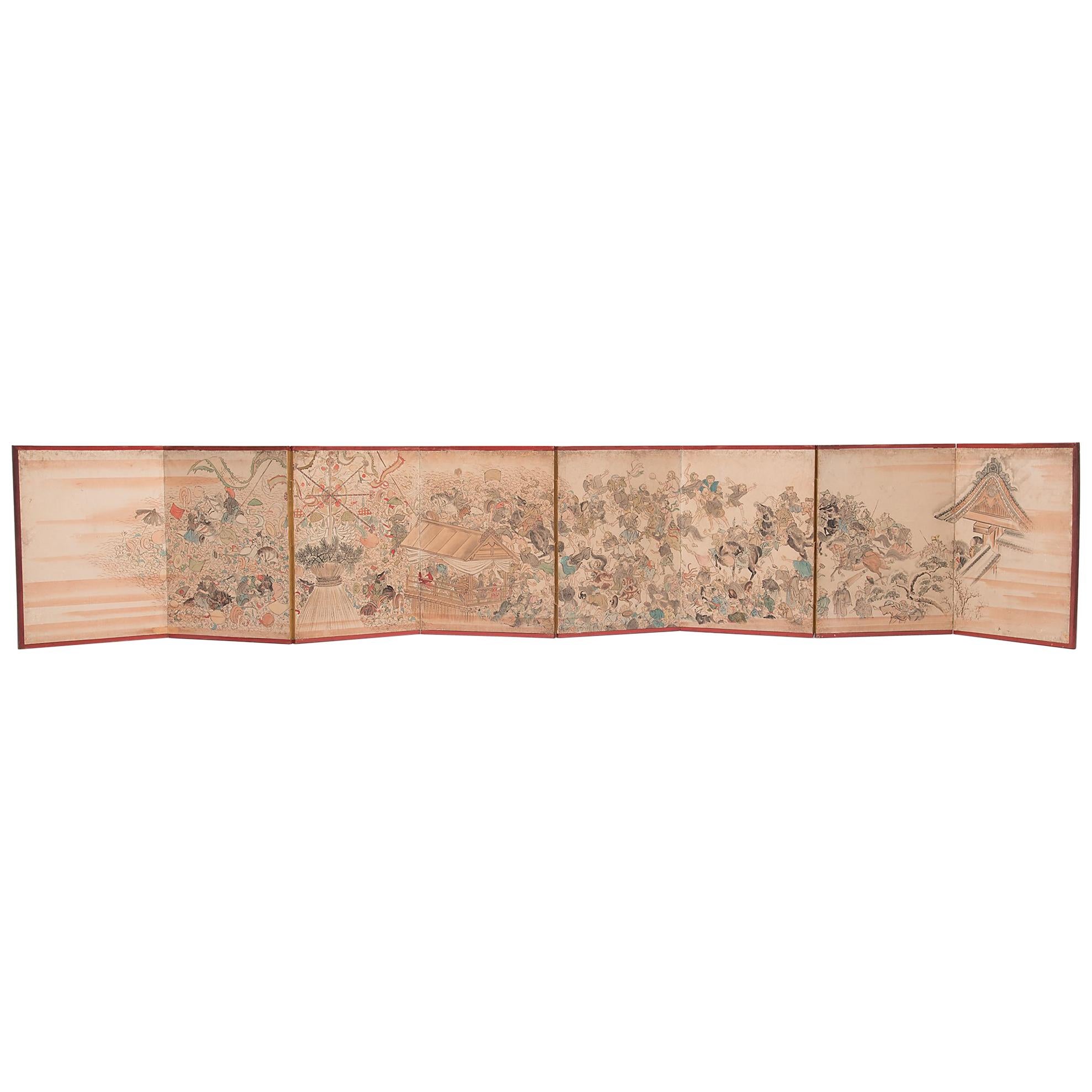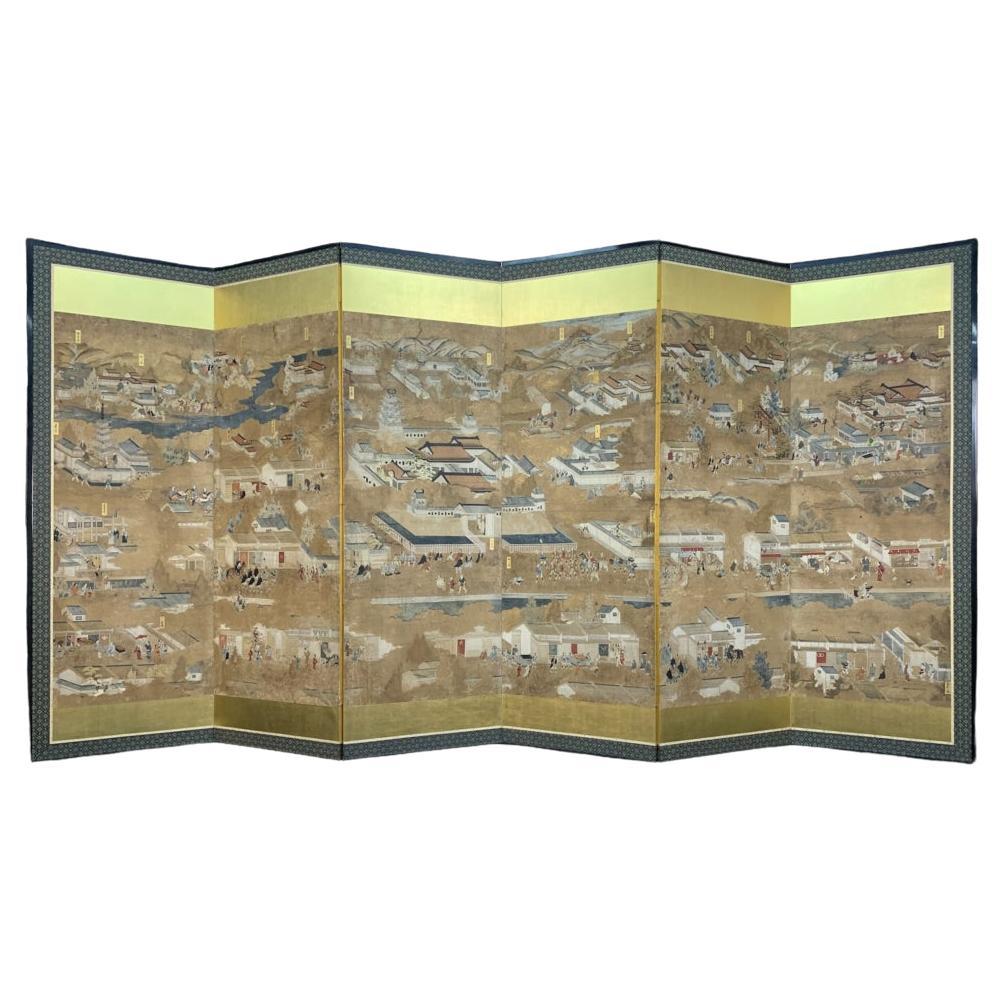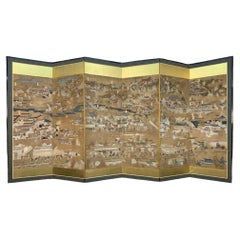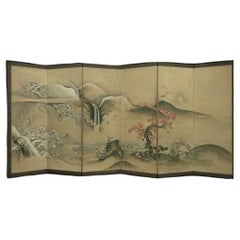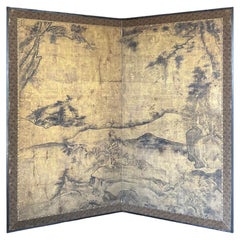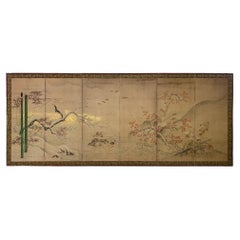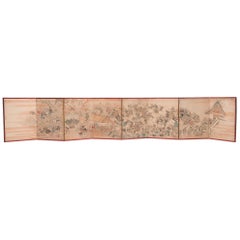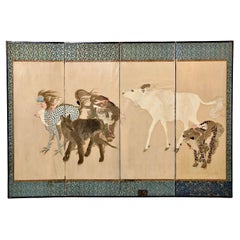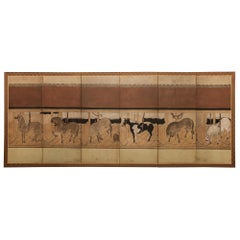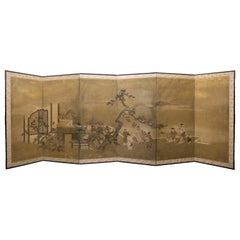Items Similar to Elegant Horse Screen. In style of Kano Tanshin
Want more images or videos?
Request additional images or videos from the seller
1 of 8
Elegant Horse Screen. In style of Kano Tanshin
$13,830
£10,485.04
€12,086.48
CA$19,477.34
A$21,598.93
CHF 11,348.63
MX$263,902.15
NOK 141,986.88
SEK 133,278.95
DKK 90,227.93
About the Item
Ink on gold.
This continuation of equine grace unfolds across a stunning gold-leaf backdrop, capturing the essence of nobility that horses represent in Japanese lore.
The screen depicts these majestic creatures amidst nature, their silhouettes etched with artistic precision that conveys both movement and stillness. Horses in Japanese art are often symbols of wealth and prestige, and this screen is a testament to that tradition, offering a glimpse into the cultural reverence for these animals.
Being unsigned, this screen echoing the style of Kano Tanshin.
Here is the information about him:
Kano Tanshin Morimasa (1653-1718) was the son of Kano Tanyu (1602-1674) by his second wife. Tanyu had originally planned for Kano Toun Masanobu to succeed him as head of his Kajibashi Kano branch; the late birth of his son, however, altered that plan. Upon his father’s death in 1674, Tanshin became head of the Kajibashi. He painted in the manner of his father; his work characterized by a light, carefree style, with an exquisite sense of color. Tanshin received the honorary Buddhist title of Hogan (eye of the law) in 1715. This tea-ceremony screen predates that.
- Similar to:Kano Tanshin (Artist)
- Dimensions:Height: 66.93 in (170 cm)Width: 146.86 in (373 cm)Depth: 0.79 in (2 cm)
- Style:Edo (Of the Period)
- Materials and Techniques:
- Place of Origin:
- Period:
- Date of Manufacture:Unknown
- Condition:Minor losses. Condition report upon request.
- Seller Location:Fukuoka, JP
- Reference Number:1stDibs: LU8121239721112
About the Seller
5.0
Vetted Professional Seller
Every seller passes strict standards for authenticity and reliability
Established in 1998
1stDibs seller since 2023
61 sales on 1stDibs
Typical response time: <1 hour
- ShippingRetrieving quote...Shipping from: Tambon Hang Dong, Thailand
- Return Policy
Authenticity Guarantee
In the unlikely event there’s an issue with an item’s authenticity, contact us within 1 year for a full refund. DetailsMoney-Back Guarantee
If your item is not as described, is damaged in transit, or does not arrive, contact us within 7 days for a full refund. Details24-Hour Cancellation
You have a 24-hour grace period in which to reconsider your purchase, with no questions asked.Vetted Professional Sellers
Our world-class sellers must adhere to strict standards for service and quality, maintaining the integrity of our listings.Price-Match Guarantee
If you find that a seller listed the same item for a lower price elsewhere, we’ll match it.Trusted Global Delivery
Our best-in-class carrier network provides specialized shipping options worldwide, including custom delivery.More From This Seller
View AllEdo Period Kyoto Screen (2/2)
Located in Fukuoka, JP
Edo Period Kyoto Screen
Period: Edo period
Size: 343 x 176 cm (134.6 x 69 inches)
SKU: RJ69/2
This stunning Edo period screen depicts typical scenes of...
Category
Antique 18th Century Japanese Edo Paintings and Screens
Materials
Silk, Wood, Paper
Edo Period Nature Screen by Kanō Tsunenobu (2/2)
Located in Fukuoka, JP
Embark on a journey through the tranquil beauty of a Japanese screen from the Edo period, crafted by the illustrious Kanō Tsunenobu, a master of the Kanō school and nephew to Kanō Ta...
Category
Antique 18th Century Japanese Edo Paintings and Screens
Materials
Paper
Early Edo Period Chinese-Inspired Screen
Located in Fukuoka, JP
This remarkable screen from the early Edo period, circa the 17th century, showcases the influence of early Chinese art forms with its intricate ink work on a gold leafed surface. The...
Category
Antique 17th Century Japanese Edo Paintings and Screens
Materials
Gold Leaf
Edo Period Seasonal Transition Screen
Located in Fukuoka, JP
Edo Period Seasonal Transition Screen
Period: Edo
Size: 368 x 153 cm
SKU: PTA148
This exquisite six-panel screen, adorned with golden flakes, beautifully portrays the seamles...
Category
Antique 19th Century Japanese Edo Paintings and Screens
Materials
Gold Leaf
Edo Period Kyoto Screen
Located in Fukuoka, JP
Edo Period Kyoto Screen
Period: Edo period
Size: 343 x 176 cm (134.6 x 69 inches)
SKU: RJ69
This stunning Edo period screen depicts typical scenes of d...
Category
Antique 18th Century Japanese Edo Paintings and Screens
Materials
Silk, Wood, Paper
Showa Period Jinmaku Screen
Located in Fukuoka, JP
Showa Jinmaku Screen
Period: Showa
Size: 376x171 cm
SKU: PTA116
Discover the historical charm of our Showa Jinmaku screen, impeccably preserved and in extremely good condition. Jinm...
Category
20th Century Japanese Showa Paintings and Screens
Materials
Wood, Paper
You May Also Like
Japanese Edo Period Festival Screen, c. 1750
Located in Chicago, IL
This 18th century folding screen is a stunning example of Japanese artistry. Beautifully painted with delicate brushwork, the evocative sc...
Category
Antique Mid-18th Century Japanese Edo Paintings and Screens
Materials
Paper
Japanese Kyoto Embroidered Screen
Located in Pasadena, CA
This is a finely stitched Kyoto embroidery screen that dates to the Meiji Era (1868 - 1912). Kyoto has been celebrated for its skilled artistic embro...
Category
Antique Late 19th Century Japanese Japonisme Paintings and Screens
Materials
Brass
Japanese Six-Panel Screen Horses in Stable
Located in Hudson, NY
Kano School painting of horses in stabile, with a monkey. Mineral pigments on mulberry paper with silk brocade border.
Category
Antique Late 18th Century Japanese Edo Paintings and Screens
Materials
Silk, Wood, Paper
Japanese Screen "the Song of Everlasting Sorrow"
Located in PARIS, FR
Six-panels screen depicting the exit from the city of a Chinese emperor on horseback and his concubine in a luxurious palanquin.
It may be a scene illustrating the poem The Song of Everlasting Sorrow (Chang hen ge, ???) written by Bai Juyi (772-846), which recounts the tragic love story between the emperor Ming Huang (also known as Tang Xuanzong, 685-762) and his favorite concubine, the beautiful Yang Guifei...
Category
Antique Late 17th Century Japanese Paintings and Screens
Materials
Silk, Wood, Paper
Japanese Six-Panel Screen
Located in Stamford, CT
A six-panel Japanese paper screen with poems, autumn flowers, bamboo fence and Mandarin ducks. Poems are believed to be earlier but were probably...
Category
Antique Mid-19th Century Japanese Edo Paintings and Screens
Materials
Paper
$19,900
Japanese Edo Six Panel Screen Merrymaking in the Chinese Countryside
Located in Rio Vista, CA
Large 19th century Japanese Edo period six panel folding byobu screen made in the Kano school style. Beautifully crafted with signature after Kano Tan'yu. Ink and natural color pigme...
Category
Antique 19th Century Japanese Edo Paintings and Screens
Materials
Gold Leaf
More Ways To Browse
Asian Horse Art
Antique Work Light
Japanese Kano Screen
18th Century Horse
Edo Screen Gold
Antique Japanese Lacquer Screens
18th Century Japanese Screens
18th Century Hand Screen
Hogan Brown
Japanese Buddhist Screen
Japanese Horse Painting
Tea Screen
Edo Japanese Screen Kano
18th Century Horse Paintings
Japanese Screen Horses
Kano Tanyu
Chinese Lacquered Screen
Pair Of Japanese Screens

